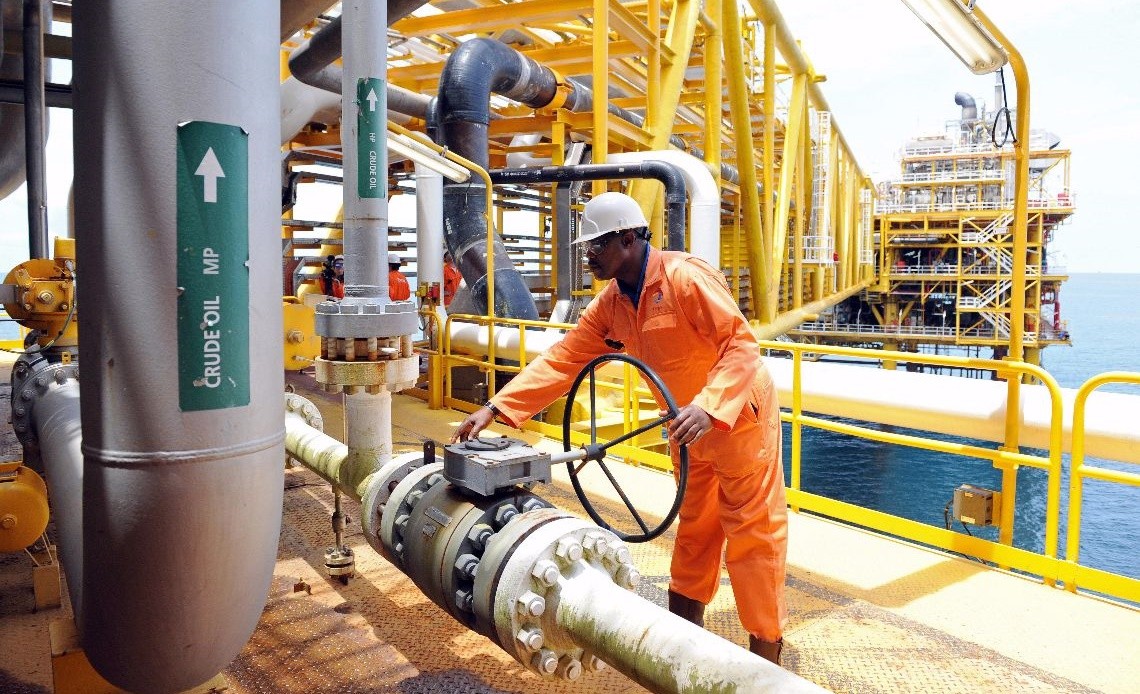Economy
Nembe Oil Spill: Expert Wants Preservation of Failed Wellhead for Analysis

By Adedapo Adesanya
An American university professor, Rick Steiner, has said between 532,000 and 1,064,000 barrels of crude oil has been spilt in the Nembe Oil Mining Lease (OML) 29 blowout, making the blowout one of the largest in world history.
Mr Steiner in a letter to the Nigerian National Petroleum Corporation (NNPC) Limited advised that the failed wellhead of the Nembe oil spill should be preserved for independent engineering forensic analysis to determine the cause of failure.
The professor, who is the Technical Advisor to the Ijaw Diaspora Council, said the failed wellhead should be assessed by either the US offshore oil regulatory agency, the Bureau of Safety and Environmental Enforcement (BSEE) and or Det Norsk Veritas (DNV) in Norway.
He maintained that the Nembe spill was much larger than government and industry statements suggest to date, and it would be prudent to correct those estimates.
“I understand that the Nembe OML 29 blowout may have been killed as of December 8, 2021, and as Technical Advisor to the Ijaw Diaspora Council, I wanted to provide you with my estimate of total discharge.
“If we assume 1-2 cubic feet of discharge per second (a very reasonable assumption), and that the blowout first occurred on November 1 (as reported by the Nembe communities), then the release lasted for a total of 38 days. This would have released a total of 532,000 barrels – 1,064,000 barrels of oil and gas, making the Nembe OML 29 blowout one of the largest in world history.
“Now that the blowout has apparently been killed, I urge you to preserve the failed wellhead for independent engineering forensic analysis to determine the cause of failure. The wellhead must be preserved as evidence, in standard criminal evidentiary procedures, to prevent any further alteration or adulteration, and then submitted to independent assessment.
“The people of Nigeria clearly deserve an independent assessment of what caused this catastrophic failure, and this is essential in preventing a repeat of this catastrophic failure in the future.
“I encourage the failed wellhead infrastructure to be assessed by either the U.S. offshore oil regulatory agency – the Bureau of Safety and Environmental Enforcement (BSEE) and/or Det Norsk Veritas (DNV) in Norway.
“Absent of a rigorous chain-of-custody, evidentiary preservation process for the failed equipment, and independent forensic evaluation, the true cause of the failure will never be conclusively determined.”
The university don regretted that the oil industry and government have been in the negative habit of underestimating oil spill volume, as was clearly seen in the 2010 United States’ deepwater horizon.
“A good example of the industry/government habit to underestimate spill volume was the 2010 Deepwater Horizon here in the U.S. BP and the US government first stated the flow rate from the failed seabed wellhead was 1,000 – 5,000 bbls/ day, and they clung to that estimate for some time (even though their internal engineers, and we, told them the flow was much higher).
“When an exact measure was finally conducted, using Particle Image Velocimetry and other engineering methodologies (by the Flow Rate Technical Group), the Macondo blowout outflow was put at 62,000 bbls/day. Again, this seems to always happen with spill volume estimates.”
Economy
Tinubu to Present 2025 Budget of N47.9trn to NASS December 17

By Aduragbemi Omiyale
On Tuesday, December 17, 2024, President Bola Tinubu will present the 2025 budget to a joint session of the National Assembly.
The size of the 2025 Appropriation Bill is about N47.9 trillion and would be presented to the parliament for approval.
Speaking at the plenary on Thursday, December 12, 2024, the President of the Senate, Mr Godswill Akpabio, said the presentation by Mr Tinubu would be at the chamber of the House of Representatives.
However, it is not certain if the lawmakers will pass the budget before December 31 to allow for a recent budget cycle of January to December.
Recall that on December 3, the senate approved the Medium Term Expenditure Framework and Fiscal Strategy Paper (MTEF/FSP) for 2025 to 2027.
This was after the President presented this the National Assembly on November 19 ahead of the consideration of the 2025 budget proposal.
In the MTEF/FSP, the government said it planned to borrow about N9.22 trillion from local and foreign sources to finance the budget deficit.
It pegged the crude oil benchmark at $75 per barrel and a daily oil production of 2.06 million barrels at an exchange rate of N1,400 to $1, and a targeted gross domestic product (GDP) growth rate of 6.4 percent.
At the plenary today, Mr Akpabio informed his colleagues that, “The President has made his intention known to the National Assembly to present the 2025 budget to the joint session of the National Assembly on December 17, 2024.”
Economy
Nigeria Adds 150,000 b/d Crude Production in November 2024

By Adedapo Adesanya
Nigeria added 150,000 barrels per day to its crude production in November 2024 as it continues to pursue an ambitious 2 million barrels per day target.
According to the Organisation of the Petroleum Exporting Countries (OPEC), Nigeria’s oil production rose to 1.48 million barrels per day in November, up from 1.33 million barrels per day the previous month.
In its Monthly Oil Market Report (MOMR), OPEC revealed that at 1.48 million barrels per day, it is the continent’s leading oil producer, surpassing Algeria’s 908,000 barrels per day and Congo’s 268,000 barrels per day.
Business Post reports that OPEC doesn’t account for condensates, which Nigeria’s accounts for in its broader 2 million barrels per day target.
Despite the surge in production levels, Nigeria is still under producing its 1.5 million barrels per day output quota under a deal involving OPEC and 10 other producers known as OPEC+.
OPEC said it relied on primary data gotten through direct communication, noting that secondary sources reported 1.417 million barrels per day as Nigeria’s crude production in November — up from 1.4 million barrels per day in October.
The data also shows that OPEC’s total oil production among its 12 members rose by 104,000 barrels per day in the month under review.
According to secondary sources, the total of the 12 OPEC countries’ crude oil production averaged 26.66 million barrels per day in November 2024.
“Crude oil output increased mainly in Libya, Iran, and Nigeria, while production in Iraq, Venezuela, and Kuwait decreased”, OPEC said.
“At the same time, total non-OPEC DoC crude oil production averaged 14.01 mb/d in November 2024, which is 219 tb/d higher, m-o-m. Crude oil output increased mainly in Kazakhstan and Malaysia,” the organisation added.
In a related development, OPEC trimmed its 2024 and 2025 oil demand growth forecasts for the fifth time this year.
Now, the cartel expects the world’s oil demand growth at 1.61 million barrels per day from the previously 1.82 million barrels per day.
For 2025, OPEC says the world oil demand growth forecast is now at 1.45 million barrels per day, a 900,000 barrels per day cut from the previously expected 1.54 million barrels per day.
On the changes, OPEC says that the downgrade for this year owes to more bearish data received in the third quarter of 2024 while the projections for next year relate to the potential impact that will arise from US tariffs.
Economy
Afriland Properties, Geo-Fluids Shrink OTC Securities Exchange by 0.06%

By Adedapo Adesanya
The duo of Afriland Properties Plc and Geo-Fluids Plc crashed the NASD Over-the-Counter (OTC) Securities Exchange by a marginal 0.06 per cent on Wednesday, December 11 due to profit-taking activities.
The OTC securities exchange experienced a downfall at midweek despite UBN Property Plc posting a price appreciation of 17 Kobo to close at N1.96 per share, in contrast to Tuesday’s closing price of N1.79.
Business Post reports that Afriland Properties Plc slid by N1.14 to finish at N15.80 per unit versus the preceding day’s N16.94 per unit, and Geo-Fluids Plc declined by 1 Kobo to trade at N3.92 per share compared with the N3.93 it ended a day earlier.
At the close of transactions, the market capitalisation of the bourse, which measures the total value of securities on the platform, shrank by N650 million to finish at N1.055 trillion compared with the previous day’s N1.056 trillion and the NASD Unlisted Security Index (NSI) went down by 1.86 points to wrap the session at 3,012.50 points compared with 3,014.36 points recorded in the previous session.
The alternative stock market was busy yesterday as the volume of securities traded by investors soared by 146.9 per cent to 5.9 million units from 2.4 million units, as the value of shares transacted by the market participants jumped by 360.9 per cent to N22.5 million from N4.9 million, and the number of deals increased by 50 per cent to 21 deals from 14 deals.
When the bourse closed for the day, Geo-Fluids Plc remained the most active stock by volume (year-to-date) with 1.7 billion units valued at N3.9 billion, followed by Okitipupa Plc with 752.2 million units worth N7.8 billion, and Afriland Properties Plc 297.5 million units sold for N5.3 million.
Also, Aradel Holdings Plc, which is now listed on the Nigerian Exchange (NGX) Limited after its exit from NASD, remained the most active stock by value (year-to-date) with 108.7 million units sold for N89.2 billion, trailed by Okitipupa Plc with 752.2 million units valued at N7.8 billion, and Afriland Properties Plc with 297.5 million units worth N5.3 billion.
-

 Feature/OPED5 years ago
Feature/OPED5 years agoDavos was Different this year
-
Travel/Tourism8 years ago
Lagos Seals Western Lodge Hotel In Ikorodu
-

 Showbiz2 years ago
Showbiz2 years agoEstranged Lover Releases Videos of Empress Njamah Bathing
-

 Banking6 years ago
Banking6 years agoSort Codes of GTBank Branches in Nigeria
-

 Economy2 years ago
Economy2 years agoSubsidy Removal: CNG at N130 Per Litre Cheaper Than Petrol—IPMAN
-

 Banking2 years ago
Banking2 years agoFirst Bank Announces Planned Downtime
-

 Sports2 years ago
Sports2 years agoHighest Paid Nigerian Footballer – How Much Do Nigerian Footballers Earn
-

 Technology4 years ago
Technology4 years agoHow To Link Your MTN, Airtel, Glo, 9mobile Lines to NIN


















